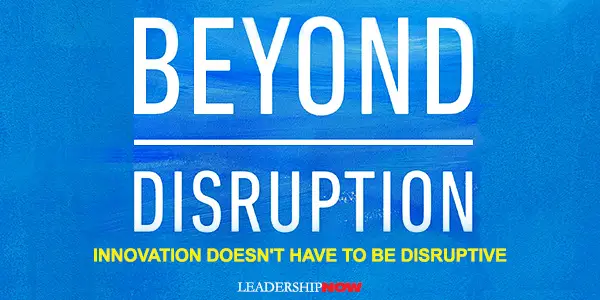Beyond Disruption: Innovation Doesn’t Have to Be Disruptive


DISRUPTION has become synonymous with innovation. It is the dominant view of how growth is created. But disruptive doesn’t have to be destructive.
With disruptive creation, “the new comes at the expense of the old and its associated companies and jobs, creating a win-lose or winner-takes-most economic outcome. In contrast, nondisruptive innovation is “achieved without disrupting a preexisting market and its associated companies and jobs.”
In Beyond Disruption: Innovate and Achieve Growth without Displacing Industries, Blue Ocean Strategy authors W. Chan Kim and Renée Mouborgne, present another path for business growth without socially disruptive consequences. Nondisruptive innovation is not new, but conventional thinking leads us to pursue disruptive innovation before we consider growth by nondisruptive innovation. Focused on disruption, we miss opportunities for nondisruptive innovation.
The authors highlight a wide variety of examples of nondisruptive-market-creating innovations to help expand our view of innovation.
The goal is to identify and solve brand-new problems or seize brand-new opportunities outside the boundaries of existing industries to unlock nondisruptive creation. “This approach begins with asking: Are there brand-new opportunities we can solve beyond existing industry boundaries?”
As your focus shifts in this way, so do the opportunities you see to create new markets that eat at neither the margins nor the core of existing industries and established players. In this way, virtually all the demand created is new, resulting in nondisruptive growth.
The authors advocate for nondisruptive creation because it will create new jobs without displacing others. “While all new markets hold the promise of creative new growth and jobs, helping to close the jobs gap, those based on disruptive creation do so at the cost of existing jobs in the short to medium term.”
They have created a framework around three paths to market-creating innovation and growth. The type of path you end up on depends on the problem you are trying to solve or the opportunity you are trying to address—the question you are asking.
As seen in the chart above, offering a breakthrough solution to an industry’s existing problem sets you on the path to disruptive creation and disruptive growth. Identifying and solving a brand-new problem or seizing a brand-new opportunity outside existing industry boundaries sets you on the path to nondisruptive creation and nondisruptive growth. Between these two ends of the market-creating-innovation spectrum is redefining and existing industry problem and then solving the redefined problem. This is the essence of blue ocean strategy, which generates a more balanced blend of disruptive and nondisruptive growth.
Start With the Right Perspective
If you want to generate nondisruptive creation, you must start with the right perspective(s). There are three.
First, we tend to allow our thinking to be constrained by our environment rather than freed by our imagination. We are not bound by the world as it is. Look beyond the existing market and environment.
Second, nondisruptive creators don’t confuse the ends with the means. “They see technology as a great enabler but realize that value innovation—offering buyers a leap in value—is what ultimately creates a nondisruptive new market.” Instead of leading with technology innovation, lead with value innovation. “Successful nondisruptive creators think value innovation first, and then technology to achieve that end.” Stay focused on value innovation.
Third, nondisruptive creators look for creative ideas from anyone and everyone, not just from the “creative types.” “It takes a network of people with differing perspectives and skills to bring any nondisruptive creation into existence—to cultivate, refine, and collectively figure out what must be learned or unlearned and where the clues are as you draw from here and there and put it all together to realize your new offering.”
Once we have the right mindset, the task becomes making it happen. The second half of the book deals with how to identify, unlock, and realize the nondisruptive opportunity.
The challenge for governments and society will be to create new jobs that don’t displace others. That is as much an economic imperative as it is a moral one—which is another key reason why nondisruptive market creation is about to become even more important.
Follow us on Instagram and Twitter for additional leadership and personal development ideas.
